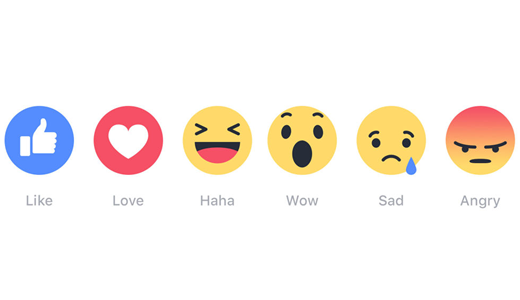For 12 years, Facebook’s myriad users were able to signal their approval of a friend’s post in just one way: with the now iconic thumbs-up “Like” emoji. But obviously there are other potential responses to a post, a reality that Facebook execs have been grappling with for a while now.
So, after a year of research, Facebook recently unveiled five new Reaction icons for users to respond to someone’s post: Love (a white heart against a red background), Haha (a laughing emoji), Wow (an emoji with a wide open mouth, big eyes and arched eyebrows), Sad (an emoji shedding a single tear) and Angry (a steamed-looking frowny face whose digital head is turning red).
While the new Reaction buttons allow users to interact more specifically with others’ content—seemingly a response to customers’ feedback—they also give Facebook a much more specific glimpse at individuals’ interests, convictions and tastes. Writes Slate’s Will Oremus:
Facebook will tell you that the new reactions are all about giving users new ways to communicate and express themselves. No doubt that’s part of it. Users have long complained that like doesn’t feel appropriate in a lot of circumstances, such as when a friend’s loved one has died or an acquaintance posts a political screed that you find interesting but also troubling. But, like almost everything Facebook does, there is a double purpose at work here—and that second purpose involves data. Specifically, Facebook is now going to be able to collect, and profit from, a whole lot more of it.
As far as how Facebook uses that treasure trove of emojional data, Oremus speculates that the social media juggernaut will be able to fine-tune advertising even further than it already does. “Reaction buttons, applied to Facebook’s massive audience, could amount to a valuable analytics tool for [advertisers]—and for Facebook, which places a high priority on showing its users ads that they find worthwhile,” he writes. “Advertisers have also always been concerned with the editorial context amid which their ads will appear. In the future, Facebook might be able to ensure that their ads come sandwiched between posts that are making people happy or that they never appear alongside posts that are making people angry.”
What might seem like an innocuous response to someone’s post, then, provides Zuckerburg and Co. with an increasingly sophisticated digital portrait of those of us who enthusiastically embrace the social network’s brave new emojional options. Looked at from that perspective, what might initially seem kind of cool takes on a decidedly creepy tinge, for me at least.
And on a more basic level—again, for me—it also makes Facebook even more overwhelming than it already feels. I can barely keep up with close friends as it is, let alone legions more via Facebook’s ubiquitous feed. Because of that, I post (and read others’ posts) pretty sparingly. So now I have even more choices to make with regard to how I respond to people’s posts.
And that makes me feel just a bit more tired just thinking about logging in to see what’s happening on my Facebook profile.
Then again, maybe being able to hit the Wow emoticon for a friend’s post will seem so satisfying that all my mild misgivings will digitally dissolve and just become another normal part of my Facebook experience—which is exactly what Mark Zuckerberg is hoping will happen.






Recent Comments